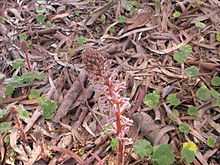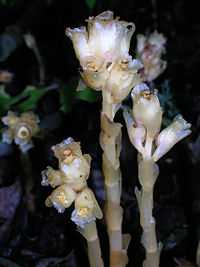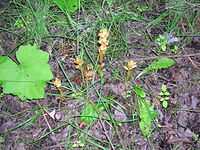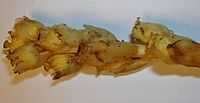Orobanche minor
Cimino, Alessio; Basso, Sara; Andolfi, Anna (10/1/14). "Effect of Fungal and Plant Metabolites on Broomrapes (OrobancheandPhelipanchespp.) Seed Germination and Radicle Growth". Agricultural and Food Chemistry 62 (43): 10485–10492. doi:10.1021/jf504609w. Check date values in: |date= (help);
| Common broomrape | |
|---|---|
 | |
| Orobanche minor | |
| Scientific classification | |
| Kingdom: | Plantae |
| (unranked): | Angiosperms |
| (unranked): | Eudicots |
| (unranked): | Asterids |
| Order: | Lamiales |
| Family: | Orobanchaceae |
| Genus: | Orobanche |
| Species: | O. minor |
| Binomial name | |
| Orobanche minor James Edward Smith | |
Orobanche minor, (common broomrape, lesser broomrape, small broorape or clover broomrape), is a holoparasitic angiosperm belonging to the genus Orobanche; a genus of about 150 non-photosynthetic plants that parasitize other autotrophic plants.
Characteristics and growth requirements

O. minor grows to 0.5 m (1 ft 8 in) and is a perennial. The flowers are hermaphrodite.
Common broomrape grows in a wide variety of soils, namely moist, light (sandy), medium (loamy) and heavy (clay) soils that are acid, neutral or basic. It can grow in semi-shade or in full sunlight.[1]
The species appears in a wide range of colours from red-brown, yellow-brown to purple. Yellow specimens are also not uncommon and it's this extreme variability that makes identification on the basis of size or colour uncertain.[2]
Common broomrape is parasitic on various members of the pea (Fabaceae) and daisy (Asteraceae) families. Although widespread, its appearance is sporadic; despite this it can occur in vast colonies from time to time. The main flowering season is from May until the end of August. The species has efficient seed dispersal and is largely inbreeding so that populations preferentially parasitizing a particular species which has its own clear ecological preferences may become effectively isolated and eventually may produce distinct taxa.[3]
The plants are attached to their host by means of haustoria, which transfer nutrients from the host to the parasite. Only the hemiparasitic species possess an additional extensive root system. The root system is reduced as its function is mainly anchorage of the plant.
Distribution
Common broomrape is one of the most widespread species, and is native to Southern Europe,[4] but has been widely introduced elsewhere, for example in the United States.[5] In the United Kingdom it is widely recorded in southern England, less common in Wales, rarely recorded in lowland Scotland and absent from the Highlands and outer islands.[6]
Taxonomy
Phylogenetic analyses have placed this species in the taxonomically difficult Minores species complex.[7][8] Four infraspecific taxa of Common broomrape are currently recognised in the United Kingdom: O. minor var. minor, O. minor var. flava, O. minor var. compositarum and O. minor subsp. maritima.[9][10] Chromosome No.: 2n = 38. The genetic structure of populations of O. minor are under investigation using molecular markers and DNA sequencing to help resolve the taxonomic and nomenclatural problems that have historically been linked with this species.[11]
Hosts and speciation


The common broomrape is highly generalist in its host range, and can infect hundreds of species in families from the Ranunculaceae to the Poaceae (=Gramineae) but with a clear preference for the Fabaceae (=Leguminosae) and Asteraceae (=Compositae).[9] However races occurring on different species of host are genetically divergent[12] and physiologically adapted to their local hosts, and may therefore be in a state of incipient speciation.[13] Urgent conservation efforts are required as the survival of some intraspecific taxa is very uncertain.[11]
References
- ↑ Plants for a Future Retrieved: 2011-08-07
- ↑ First Nature Retrieved: 2011-08-07
- ↑ Watsonia Retrieved: 2011-08-07
- ↑ Kreutz, C.A.J. (1995) Orobanche: Die Sommerwurzarten Europas. Maastricht: Stichting Natuurpublicaties (Limburg, Germany).
- ↑ Eizenberg, H.; Colquhoun, JB.; Mallory-Smith, C.A. (2003). Variation in clover response to small broomrape (Orobanche minor). Weed Science 51: 759-763.
- ↑ NBN Gateway Retrieved: 2011-08-08
- ↑ Manen JF, Habashi C, Jeanmonod D, Park JM, Schneeweiss GM, 2004. Phylogeny and intraspecific variability of holoparasitic Orobanche (Orobanchaceae) inferred from plastid rbcL sequences. Molecular Phylogenetics and Evolution 33: 482–500.
- ↑ Schneeweiss, G.M.; Colwell, A.; Park, J-M.; Jang, C-G.; Stuessy, T.F. (2004). Phylogeny of holoparasitic Orobanche (Orobanchaceae) inferred from nuclear ITS sequences. Molecular Phylogenetics and Evolution 30: 465–478.
- ↑ 9.0 9.1 Rumsey, F.J.; Jury, S,L.; (1991). An account of Orobanche L. in Britain and Ireland. Watsonia 18: 257-295.
- ↑ Rumsey, F.J.; 2007. A reconsideration of Orobanche maritima Pugsley (Orobanchaceae) and related taxa in southern England and the Channel Islands. Watsonia 26: 473-476
- ↑ 11.0 11.1 BSBI Retrieved: 2011-08-07
- ↑ Thorogood, C.J.; Rumsey, F.J.; Harris, S,A.; Hiscock, S.J. (2008). Host-driven divergence in the parasitic plant Orobanche minor Sm. (Orobanchaceae). Molecular Ecology 17: 4289–4303.
- ↑ Thorogood, C.J.; Rumsey, F.J.; Hiscock, S.J. (2009). Host-specific races in the holoparasitic angiosperm Orobanche minor: implications for speciation in parasitic plants. Annals of Botany 103: 1005–1014.
Further reading
Cimmino, Alessio; Andolfi, Anna; Basso, Sara (1 October 2014). "Previous Article Next Article Table of Contents Effect of Fungal and Plant Metabolites on Broomrapes (Orobanche and Phelipanche spp.) Seed Germination and Radicle Growth". Agricultural and Food Chemistry 63 (43): 10485–10492. doi:10.1021/jf504609w.
Mallory-Smith, Carol; Colquhoun, Jed (October 7, 2011). "Small Broomrape (Orobanche minor) in Oregon and the 3 Rs: Regulation, Research, and Reality". Weed Science 63 (1): 277-282. doi:10.1614/WS-D-11-00078.1.
External links
| Wikimedia Commons has media related to Orobanche minor. |